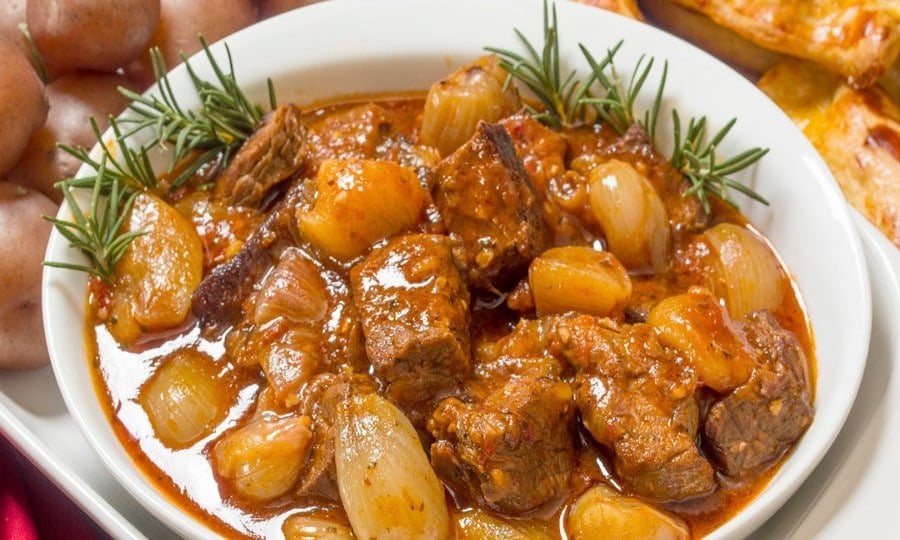This rabbit stew is a big fat Greek classic with many variations, none more memorable than on a summer evening on an Ionian island
The best meal I ever had in Greece wasn’t mine. It was my friend Nic’s; I tried a mouthful and abandoned my plate for his kouneli stifado – rabbit stew, an unfussy Greek classic that was probably a gift from the Venetians. We tend to think of dill, oregano and thyme as Greek flavours, but this dish, and others, use exotic spices – cinnamon, allspice, nutmeg, and cloves.
I sailed to Greece; I’m still here as autumn turns to winter when an aromatic stifado takes centre stage. Its gently warming spices and balance of sweet and sour make it a favourite Sunday family meal, a comfort food to beat all others. These flavours will forever evoke Greece for me – particularly Greece in winter.
That said, this memorable version also made a perfect summer dinner, with oregano fries in a cracking little taverna in the back streets of Zakynthos town, on the island of the same name. Stifado doesn’t often feature in tourist restaurants – it takes time to cook well – but O Zohios caters for regulars and the few lucky tourists who stumble upon it. Kostas the chef, a generous bear of a man, joined us after service and we were there late into the night while I tried to prise the recipe out of him. All of his food was great, but that stifado completely arrested my senses. I sent friends a blurred picture of it – half eaten – proclaiming I’d found the best food in Greece.
As with many Greek classics, each region and family has its own stifado (it may be made with octopus in fishing towns, and there are vegetarian mushroom stifados) and everyone argues about techniques and non-negotiable ingredients. Onions, but which kind? Wine, but how sweet? Tomatoes for sure – yet stifado predates tomatoes. It’s pointless trying to get a definitive version but by general agreement rabbit, increasingly rare on menus, is authentic. Kostas’s rabbit cooked long and slow, fell off the bone without encouragement. The rich sauce – not too much – was smooth with olive oil, warm with spices and had a moreish tang that came from the meat being marinated in vinegar overnight to tenderise it. Tomatoes, spice, garlic, onion, wine, lots of time. Perfection.
It’s the dish I’ll long for when I set sail for foreign ports.
Rabbit stifado
Stifado is almost always made with lots of tiny onions; sometimes, it’s also made with lots of tomatoes. The version below is rich and aromatic with spices. If you prefer a sharper flavour, add half a tin of chopped tomatoes after the wine. Rabbits can take anywhere from an hour to three hours to cook, depending on the age of the rabbit and whether it is wild or not. Stifado can also be made with chicken, game birds, and even goat or venison. Serve with crusty bread and a salad of bitter leaves with a sharp dressing, to cut through the richness of the stifado.
Olive oil for cooking
1 whole rabbit, skinned and jointed, without offal
15 small onions or shallots
6 cloves garlic
1 tbsp tomato puree
250ml red wine
1 tsp red wine vinegar
1 bay leaf
3cm cinnamon stick
8 rosemary leaves, finely chopped
500ml hot water
¼ tsp freshly ground black pepper
Salt
Preheat the oven to 160C. In a large oven-proof pan (it will need a lid), warm a tablespoon of olive oil over high heat. Place half the rabbit pieces in the pan and brown thoroughly. Remove from the pan and set aside, then do the same with the other half. Add the onions and garlic to the pan and fry for three minutes, stirring – just long enough for them to get a little colour. Add the tomato puree and cook for two minutes, stirring again. Add the red wine, and deglaze the pan: let the wine bubble and stir, scraping up any burned bits from the bottom and sides of the pan. Add the vinegar, bay leaf, cinnamon stick and rosemary, stir, then return the meat to the pan.
Add the water and the pepper, plus a generous grinding of salt. Bring to the boil, cover with a lid and place in the oven. Cook for an hour, then check to see if the meat is becoming tender; if not, return to the oven for 30 minutes. Continue to check every 30 minutes until the meat is falling off the bone – this may take as long as three hours.
When the meat is tender, remove the pan from the oven. Take the meat out of the pan and set aside. Remove and discard the cinnamon stick. Place the pan over medium heat and reduce the liquid left in the pan (this may not need to be done if the meat has been in the oven for a very long time). Reduce until just thickened and saucy. Taste and add more salt and pepper, as necessary.
Source: theguardian.com




